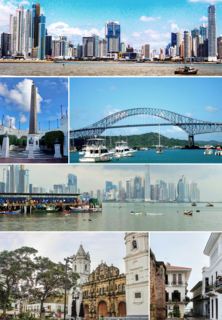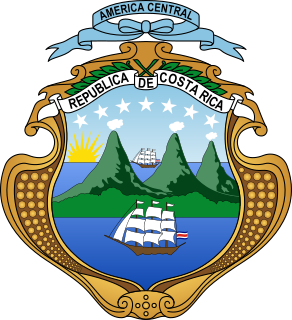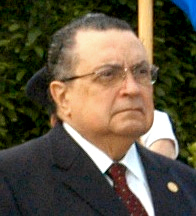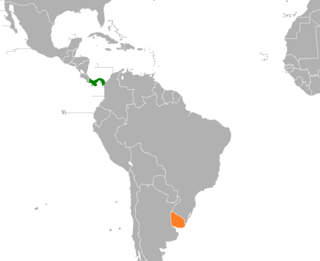Francisco Vicente de la Espriella Navarro (died April 22, 1916 in Panama City) was a Panamanian lawyer, merchant and politician. [1] De la Espriella Navarro was the first Minister of Foreign Affairs of the Republic of Panama. [2]

Panama City is the capital and largest city of Panama. It has an urban population of 880,691, with over 1.5 million in its metropolitan area. The city is located at the Pacific entrance of the Panama Canal, in the province of Panama. The city is the political and administrative center of the country, as well as a hub for banking and commerce.
Francisco Vicente de la Espriella Navarro was born to José Francisco de la Espriella Díaz and Candelaria Navarro del Real. [3] His family originated from the Spanish region Asturias. [4] De la Espriella Navarro lived in Cartagena, Nueva Granada, and practiced law in the city, but later moved to Panama. [5] De la Espriella Navarro married Constancia Macaya Artuz in 1872. [1]

Spain, officially the Kingdom of Spain, is a country mostly located in Europe. Its continental European territory is situated on the Iberian Peninsula. Its territory also includes two archipelagoes: the Canary Islands off the coast of Africa, and the Balearic Islands in the Mediterranean Sea. The African enclaves of Ceuta, Melilla, and Peñón de Vélez de la Gomera make Spain the only European country to have a physical border with an African country (Morocco). Several small islands in the Alboran Sea are also part of Spanish territory. The country's mainland is bordered to the south and east by the Mediterranean Sea except for a small land boundary with Gibraltar; to the north and northeast by France, Andorra, and the Bay of Biscay; and to the west and northwest by Portugal and the Atlantic Ocean.

Asturias, officially the Principality of Asturias, is an autonomous community in north-west Spain. It is coextensive with the province of Asturias, and contains some of the territory that was part of the larger Kingdom of Asturias in the Middle Ages. Divided into eight comarcas (counties), the autonomous community of Asturias is bordered by Cantabria to the east, by Castile and León to the south, by Galicia to the west, and by the Bay of Biscay to the north.

The city of Cartagena, known in the colonial era as Cartagena de Indias, is a major port founded in 1533, located on the northern coast of Colombia in the Caribbean Coast Region. It was strategically located between the Magdalena and Sinú rivers and became the main port for trade between Spain and its overseas empire, establishing its importance by the early 1540s. During the colonial era it was a key port for the export of Peruvian silver to Spain and for the import of enslaved Africans under the asiento system. It was defensible against pirate attacks in the Caribbean. It is the capital of the Bolívar Department, and had a population 971,592 as of 2016. It is the fifth-largest city in Colombia and the second largest in the region, after Barranquilla. The urban area of Cartagena is also the fifth-largest urban area in the country. Economic activities include the maritime and petrochemicals industries, as well as tourism.
The couple had seven children. The first son died shortly after birth. The other children were María Candelaria de la Espriella Macaya, Constancia de la Espriella Macaya, Cristina de la Espriella Macaya, Francisco Eduardo de la Espriella Macaya, Catalina de la Espriella Macaya and Josefina de la Espriella Macaya. [1] [5]
When Panama was separated from Colombia, de la Espriella Navarro was put in charge of the foreign relations of the Provisional Government Junta of the new state. [2]
The properties of de la Espriella Navarro in Costa Rica amounted to a value of 109,659 colones and 74 céntimos at the time of his deaths. His widow inherited the property, and settled down in San José. [1] His son, Francisco Eduardo de la Espriella Macaya, became the Panamanian ambassador to Costa Rica. [5]

Costa Rica, officially the Republic of Costa Rica, is a country in Central America, bordered by Nicaragua to the north, the Caribbean Sea to the northeast, Panama to the southeast, the Pacific Ocean to the southwest, and Ecuador to the south of Cocos Island. It has a population of around 5 million in a land area of 51,060 square kilometers. An estimated 333,980 people live in the capital and largest city, San José with around 2 million people in the surrounding metropolitan area.
The colón is the currency of Costa Rica. The plural is colones. The ISO 4217 code is CRC.

San José is the capital and largest city of Costa Rica. Located in the mid-west of the Central Valley, San José is the seat of national government, the focal point of political and economic activity, and the major transportation hub of this Central American nation. The population of San José Canton was 288,054 in 2011, and San José’s municipal land area measures 44.2 square kilometers, and an estimated 333,980 residents in 2015. The metropolitan area stretches beyond the canton limits and has an estimated population of over 2 million in 2017. The city is named in honor of Joseph of Nazareth.
Francisco Vicente de la Espriella Navarro is the great grandfather of Costa Rican Social Christian Unity Party politician Abel Pacheco de la Espriella (President of Costa Rica 2002-2006). [5] [6]

The Social Christian Unity Party is a centre-right political party in Costa Rica.

The President of Costa Rica is the head of state and head of government of Costa Rica. The President is currently elected in direct elections for a period of four years, which is not immediately renewable. Two Vice presidents are elected in the same ticket with the president. The president appoints the Council of Ministers. Due to the abolition of the military of Costa Rica in 1948, the president is not a Commander-in-chief, unlike the norm in most other countries, although the Constitution does describe him as commander in chief of the civil defense public forces.









